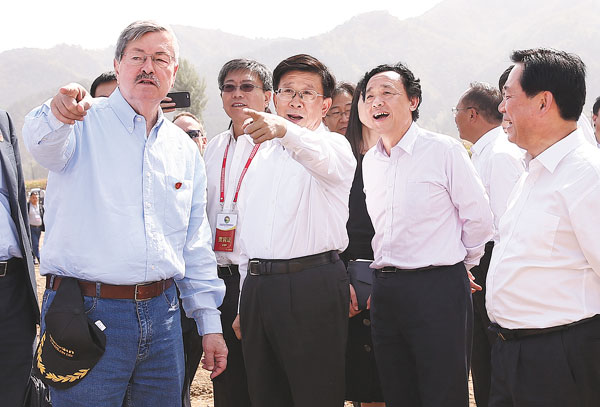


(US Ambassador Terry Branstad, Hebei Party chief Zhao Kezhi, second from left, and Qu Dongyu, third from left, vice-minister of agriculture, are among officials at the launch ceremony of a demonstration farm in Luanping county, North China's Hebei province on Saturday. Photo / CHINA DAILY)
Expertise from Iowa will be put to use in Hebei, officials explain.
Agriculture is especially important to the people of China and the United States, and agricultural cooperation contributes to stronger ties between the two countries, the US ambassador to China said at a launch ceremony of a demonstration farm on Saturday.
The China-US Friendship Demonstration Farm, in Luanping county, Hebei province, covers an area of about 1,330 hectares. It's modeled after a farm near Maxwell, Iowa, owned by Rick and Martha Kimberley and their son Grant.
"The farm … stands as an example of how we can exchange information and ideas, and maintain a growing and improving trade relationship," said Ambassador Terry Branstad, a former governor of the US state of Iowa.
In his speech, Branstad recalled his interactions with President Xi Jinping dating to 1985, when Xi led an agricultural delegation from Hebei province to Iowa when Branstad was governor.
In 2012, invited by Branstad, Xi visited Iowa a second time. He visited the Kimberleys' farm, which he said Chinese farms should be modeled after, according to documents provided by the Luanping government.
The Kimberley farm has an area of about 1,600 hectares, similar to the demonstration farm being built in Hebei. Yet the farm only employs three people due to its use of technology and management, Rick Kimberley said.
"We have monitors that can make records of what we are planning. … The records decide the planting rates and when we harvest we know the yields all through the field. … We use GPS to make sure that we don't over plant, overuse chemicals or over-fertilize," Kimberley said, adding that every step is monitored and standardized in the farm operation.
In Luanping, farms are operated on smaller scales by each household, usually 0.09 hectare per person.
Chen Shuping, a local farmer in her 50s, works on 0.35 hectare of corn farms with her husband, like many local couples do. From planting to harvest, they use their hands and sometimes machines, such as sprayers and cultivators.
Her daughter and son, who are going to school and working in the city nearby, decided not to come home to help take care of the farmland, Chen said.
"If we manage the farmlands together and apply machinery and technology, and more importantly develop the production mode and additional industries, we can improve the efficiency in many aspects," said Zhang Yueyong, president of the agricultural industry of Rise?Sun, the demonstration farm project's main investor in Hebei.
Zhang said they will explore more possibilities in cooperation with the Kimberley farm and based on the local situation.
"We'll train the farmers to use machines, learn technologies, so they can work and even manage the farm and factories," Zhang said.
Kimberley said he'd love to bring the technology and equipment from his farm to Hebei, help train people and show how to adapt to the changes as farmers, including how to manage the farm, dry and store the grains, and use machinery.
"I am a farmer, and I have great passion for Chinese farmers. I know how hard it is to be a farmer. I want to help the farmers and make a better life for them and make more profits," he said.
The agricultural cooperation between China and the US has made positive progress in recent years, cooperative mechanisms have been improved, agricultural technology exchanges have been strengthened and agricultural trade has been developed rapidly, according to Qu Dongyu, China's vice-minister of agriculture.
 Fire brigade in Shanghai holds group wedding
Fire brigade in Shanghai holds group wedding Tourists enjoy ice sculptures in Datan Town, north China
Tourists enjoy ice sculptures in Datan Town, north China Sunset scenery of Dayan Pagoda in Xi'an
Sunset scenery of Dayan Pagoda in Xi'an Tourists have fun at scenic spot in Nanlong Town, NW China
Tourists have fun at scenic spot in Nanlong Town, NW China Harbin attracts tourists by making best use of ice in winter
Harbin attracts tourists by making best use of ice in winter In pics: FIS Alpine Ski Women's World Cup Slalom
In pics: FIS Alpine Ski Women's World Cup Slalom Black-necked cranes rest at reservoir in Lhunzhub County, Lhasa
Black-necked cranes rest at reservoir in Lhunzhub County, Lhasa China's FAST telescope will be available to foreign scientists in April
China's FAST telescope will be available to foreign scientists in April "She power" plays indispensable role in poverty alleviation
"She power" plays indispensable role in poverty alleviation Top 10 world news events of People's Daily in 2020
Top 10 world news events of People's Daily in 2020 Top 10 China news events of People's Daily in 2020
Top 10 China news events of People's Daily in 2020 Top 10 media buzzwords of 2020
Top 10 media buzzwords of 2020 Year-ender:10 major tourism stories of 2020
Year-ender:10 major tourism stories of 2020 No interference in Venezuelan issues
No interference in Venezuelan issues
 Biz prepares for trade spat
Biz prepares for trade spat
 Broadcasting Continent
Broadcasting Continent Australia wins Chinese CEOs as US loses
Australia wins Chinese CEOs as US loses